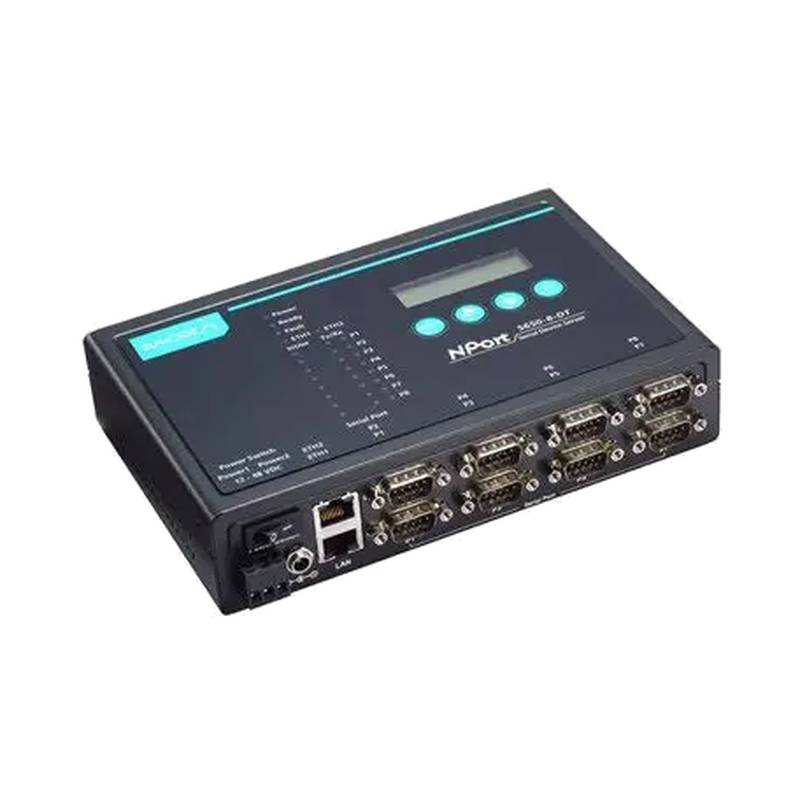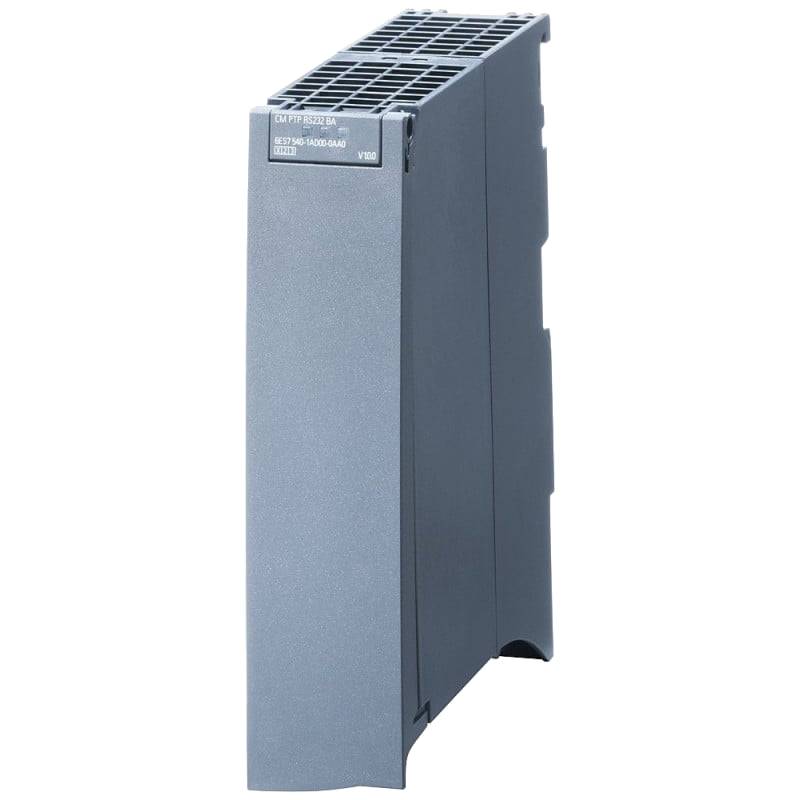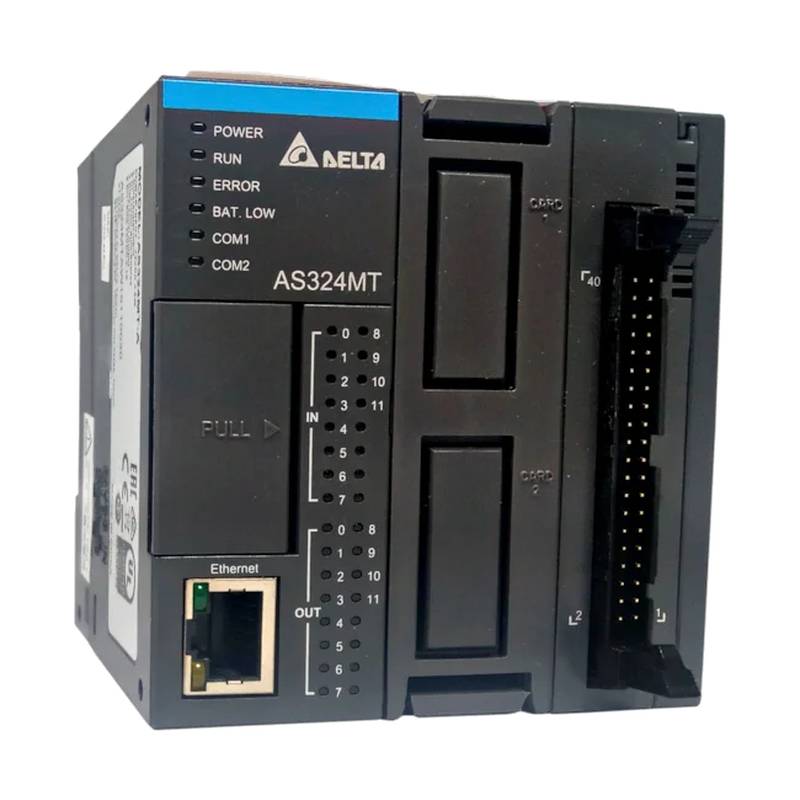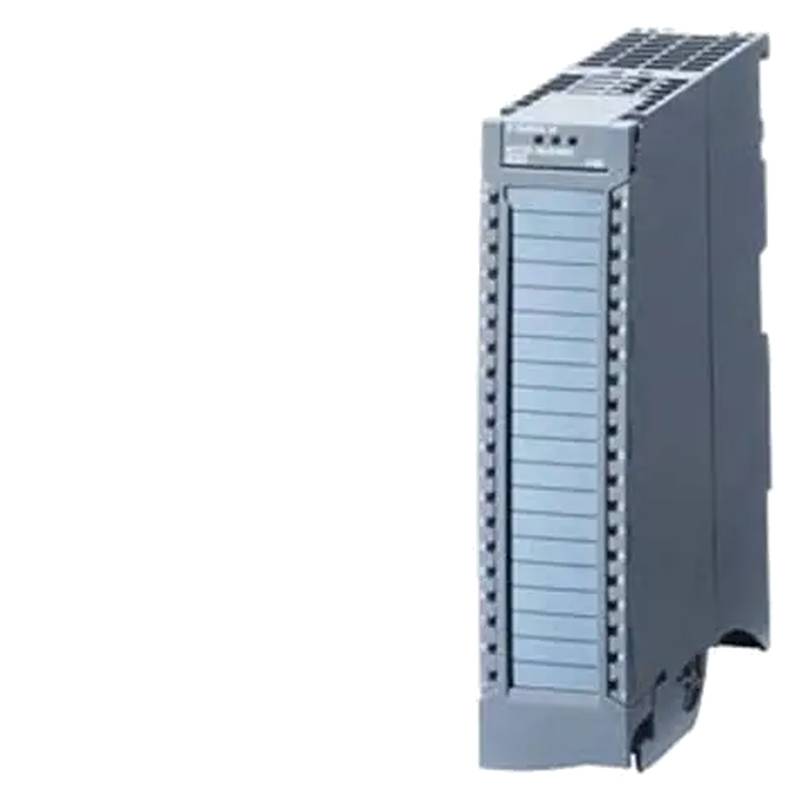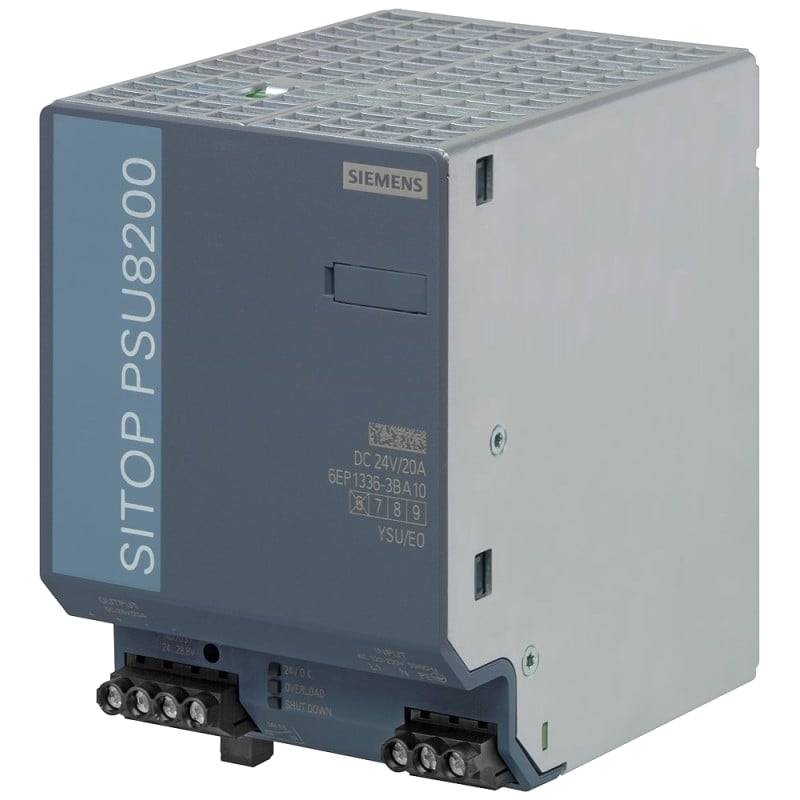
The Moxa NPort 5650-8-DT is an industrial-grade serial device server engineered to bridge the gap between legacy serial devices and modern Ethernet networks. Its robust design and versatile connectivity options make it an indispensable tool for integrating serial equipment into IP-based systems, ensuring seamless data flow and centralized management across diverse industrial environments. The NPort 5650-8-DT offers a high-density solution with eight serial ports, supporting RS-232, RS-422, and RS-485 standards, and features two 10/100M Ethernet ports for flexible network integration. Its compact desktop form factor is ideal for applications where space is limited, eliminating the need for rack-mounting infrastructure. Key advantages include easy IP address configuration via an LCD panel, comprehensive socket operation modes (TCP Server, TCP Client, UDP, Real COM), and SNMP MIB-II for network management, enhancing its suitability for demanding industrial use.
Product Specifications
| Feature | Specification |
| :----------------------- | :------------------------------------------------------------------------------------------------------------------ |
| Serial Ports | 8 ports |
| Serial Standards | RS-232, RS-422, RS-485 |
| Serial Connectors | DB9 male |
| Ethernet Ports | 2 x 10/100M auto-sensing Ethernet (RJ45 connector) |
| Ethernet Isolation | 1.5 kV (built-in) |
| Baudrate | Supports standard baudrates up to 921.6k bps |
| Data Bits | 5, 6, 7, 8 |
| Stop Bits | 1, 1.5, 2 |
| Parity | None, Even, Odd, Space, Mark |
| Flow Control | RTS/CTS, DTR/DSR, XON/XOFF |
| RS-485 Resistors | Selectable 1k ohm, 150k ohm pull high/low resistors; 120 ohm terminator |
| Data Direction Control| Automatic Data Direction Control (ADDC) for RS-485 |
| Power Input | 12 to 48 VDC via power terminal block or power jack |
| Input Current | 615 mA @ 12 VDC |
| Reverse Polarity Prot.| Supported |
| Operating Temperature| 0 to 55°C (32 to 131°F) |
| Storage Temperature | -40 to 75°C (-40 to 167°F) |
| Humidity | 5 to 95% non-condensing |
| Housing | Metal |
| Mounting | Desktop, Wall-mount (optional kit), DIN-rail mount (optional kit) |
| Dimensions | 197 x 44 x 125 mm (without ears) |
| Weight | 1,590 g (3.51 lb) |
| Certifications | CE, FCC, UL Listed |
| MTBF | 836,374 hrs (Telcordia Standard) |
Core Features & Market Positioning
The Moxa NPort 5650-8-DT distinguishes itself in the industrial serial device server market through its high port density, robust construction, and user-friendly features tailored for challenging environments. Its compact desktop design is a significant advantage for applications with limited space, offering a cost-effective solution for expanding serial connectivity without requiring additional rack infrastructure. The inclusion of selectable RS-485 termination and pull-high/low resistors, managed via DIP switches, provides crucial flexibility for ensuring signal integrity in RS-485 networks, a common pain point in industrial settings. Furthermore, dual Ethernet ports facilitate cascade-style wiring, simplifying network setup and reducing cabling costs by eliminating the need for separate Ethernet switches for each device. The device's ability to support a wide input voltage range (12-48 VDC) and dual power inputs (terminal block and jack) enhances its reliability and ease of integration into existing power infrastructures. Market positioning is solidified by its reputation for industrial-grade reliability, evidenced by a high Mean Time Between Failures (MTBF) of 836,374 hours.
Key Application Scenarios
The versatility of the Moxa NPort 5650-8-DT makes it suitable for a broad spectrum of industrial automation and control applications. It is particularly effective in scenarios requiring the seamless integration of legacy serial devices into modern IP networks. Common applications include:
Factory Automation: Connecting PLCs, CNC machines, barcode scanners, and other serial-controlled equipment to a central SCADA or HMI system over Ethernet for real-time monitoring and control. Building Automation: Integrating environmental sensors, access control systems, and security devices that rely on serial communication into a building management system (BMS). Retail and POS Systems: Enabling network connectivity for point-of-sale terminals, receipt printers, and payment gateways that use serial interfaces. Energy Management: Facilitating the collection of data from meters, sub-meters, and control units in power grids and renewable energy installations. Transportation Systems: Integrating traffic control equipment, sensor networks, and communication devices in intelligent transportation systems (ITS).
The device's ability to handle RS-232, RS-422, and RS-485 makes it adaptable to a wide array of existing infrastructure, ensuring that investment in serial equipment is preserved while gaining the benefits of network connectivity.
Practical System Integration Guidance
Integrating the Moxa NPort 5650-8-DT into an industrial network is designed to be straightforward, with multiple configuration methods available to suit different user preferences and environments.
Initial Configuration:
Users can configure the IP address, subnet mask, and gateway using the built-in LCD panel and push buttons, which is particularly useful for initial setup without a direct network connection. Alternatively, the NPort Administrator utility, accessible via Windows, simplifies device discovery and management across the LAN. For advanced users, Telnet or web browser (HTTP/HTTPS) interfaces provide comprehensive configuration options, including socket modes and serial parameters.
RS-485 Configuration:
For RS-485 communication, careful attention to termination and pull-high/low resistors is critical for signal integrity. The NPort 5650-8-DT features DIP switches that allow manual adjustment of these resistors per port, enabling users to fine-tune settings for specific network conditions to prevent signal reflections and corruption. The Automatic Data Direction Control (ADDC) for RS-485 simplifies half-duplex communication by automatically managing data transmission direction.
Wiring:
The device provides dual Ethernet ports that can function as an integrated switch, allowing for daisy-chaining devices and reducing the need for external network infrastructure. Power can be supplied via a standard power terminal block or a DC power jack, offering flexibility in power source selection. Pinout diagrams and cable wiring guides are readily available in the user manuals to ensure correct physical connections for both Ethernet and serial interfaces.
Operation and Risk Mitigation
The NPort 5650-8-DT is equipped with features designed to enhance operational reliability and aid in troubleshooting, minimizing downtime in critical industrial applications.
Monitoring and Diagnostics:
Integrated LEDs on the front panel provide immediate visual status feedback for system, serial port activity (Tx/Rx), and Ethernet link status. These indicators are invaluable for field engineers to quickly diagnose connection issues or monitor data flow. The device also incorporates a built-in Watchdog Timer (WDT) to automatically reboot the device in case of software or hardware hangs, ensuring continuous operation.
Alerts and Warnings:
An automatic warning function, utilizing a built-in speaker and/or email notifications, alerts administrators to critical events such as Ethernet link failures or power input issues. This proactive notification system allows for prompt response to potential problems before they escalate.
Security:
For secure network integration, the device supports HTTPS (TLS 1.2) and SNMPv3 for encrypted communication and management, along with local database authentication.
Troubleshooting:
The comprehensive user manual includes a dedicated troubleshooting section with guidance on common issues, cable wiring, and LED interpretations. The reset button can be used to restore factory default settings if configuration errors occur.
Scalability & Long-Term Value
The Moxa NPort 5650-8-DT is designed to offer long-term value and adaptability within evolving industrial networks. Its ability to connect existing serial devices to Ethernet networks preserves investments in legacy equipment while enabling participation in modern IIoT (Industrial Internet of Things) architectures.
Network Expansion:
The NPort 5650-8-DT provides a high-density solution with eight serial ports, allowing for significant expansion of serial device connectivity on an Ethernet network. This is crucial for growing operations or when retrofitting older facilities.
Software Compatibility:
The device features Moxa's Real COM/TTY drivers, which maintain the original COM or TTY port behavior on the host PC. This allows existing SCADA, data acquisition, and control software that relies on COM ports to function seamlessly with networked serial devices, eliminating the need for costly software re-engineering. Support extends across various Windows and Linux operating systems, including older versions and embedded systems.
IIoT Integration:
By providing Ethernet connectivity to serial devices, the NPort 5650-8-DT acts as a vital gateway for data acquisition from industrial equipment. This data can then be leveraged by IIoT platforms for advanced analytics, predictive maintenance, and remote monitoring, driving digital transformation initiatives within an organization.
---
Frequently Asked Questions (FAQs)
Q1: What are the primary advantages of using the Moxa NPort 5650-8-DT?
The Moxa NPort 5650-8-DT offers significant advantages for industrial serial-to-Ethernet conversion. Its high port density with eight serial ports (RS-232/422/485) consolidates connectivity into a single, compact unit. The desktop form factor is ideal for space-constrained environments, eliminating rack-mounting requirements. It provides robust RS-485 support with adjustable termination and pull-high/low resistors for signal integrity. Dual Ethernet ports enable efficient daisy-chain wiring, reducing network infrastructure costs.
This device ensures reliable operation with dual power inputs (12-48 VDC) and built-in diagnostics. Features like an LCD panel for easy IP configuration and comprehensive socket modes enhance its usability. The industrial-grade construction and high MTBF rating signify its suitability for demanding environments. Overall, it bridges legacy serial devices to modern networks efficiently and reliably.
The device's market positioning is strong due to its combination of features: extensive serial port compatibility, network flexibility, ease of deployment, and Moxa's reputation for industrial reliability. It is designed to preserve investments in existing serial equipment while enabling integration into current and future networked systems.
Q2: How do I configure the IP address on the Moxa NPort 5650-8-DT?
You can configure the IP address on the Moxa NPort 5650-8-DT through several methods. The most direct approach is using the built-in LCD panel and push buttons on the device itself, which is convenient for initial setup or isolated deployments. This allows for quick configuration without needing to connect to a network or use additional software.
Alternatively, the NPort Administrator utility for Windows provides a powerful tool for discovering and configuring multiple NPort devices on your LAN. This is ideal for managing a fleet of devices or when performing bulk configuration tasks. For more advanced users or network administrators, configuration can also be performed via Telnet or a web browser (HTTP/HTTPS) connection.
These various configuration options ensure flexibility, catering to different user skill levels and network environments. Whether you prefer a hardware-based setup, a dedicated software utility, or remote web access, the NPort 5650-8-DT supports an efficient IP address assignment process.
Q3: What are the supported serial communication standards and modes?
The Moxa NPort 5650-8-DT supports a wide array of serial communication standards. It features eight ports that are fully compatible with RS-232, RS-422, and RS-485 serial interfaces, offering maximum flexibility for connecting diverse industrial equipment. This broad compatibility ensures that most legacy serial devices can be integrated without modification.
The device operates using several versatile socket modes. These include TCP Server, TCP Client, and UDP, which allow for various network communication topologies and data transmission strategies. Additionally, the Real COM mode emulates a traditional COM port on the host PC, enabling existing software applications that rely on serial port drivers to communicate seamlessly with networked devices without modification.
This combination of multi-standard serial support and flexible socket operation modes makes the NPort 5650-8-DT a highly adaptable solution for modernizing serial communication infrastructure. It bridges the gap between old and new technologies effectively.
Q4: Can the Moxa NPort 5650-8-DT be used in extreme temperature environments?
The standard Moxa NPort 5650-8-DT model is designed for an operating temperature range of 0 to 55°C (32 to 131°F). This range is suitable for many typical industrial and commercial environments. However, Moxa also offers "Wide Temperature" (-T) models of its NPort 5600-DT series, such as the NPort 5650-8-DT-T, which are specifically engineered to operate in much harsher temperature conditions, typically from -40 to 75°C (-40 to 167°F).
For applications requiring operation in extreme cold or heat, it is crucial to select the appropriate wide-temperature model. These models incorporate components that can withstand wider temperature fluctuations, ensuring reliable performance in demanding industrial settings like outdoor enclosures, unheated facilities, or high-temperature processing areas.
Always verify the specific model number and its corresponding temperature specifications to ensure it meets the environmental requirements of your application. Using the correct model guarantees optimal performance and longevity in challenging thermal conditions.
Q5: How does the dual Ethernet port feature benefit system integration?
The dual Ethernet ports on the Moxa NPort 5650-8-DT offer significant advantages for system integration, primarily by enabling efficient network cabling. These ports function as a built-in Ethernet switch, allowing for cascade or daisy-chain wiring. This means you can connect one NPort to the network or a switch, and then connect another Ethernet device or another NPort to the second port.
This cascade capability reduces the overall number of network switches required, lowering installation costs and simplifying wiring complexity, especially in deployments with many devices. It creates a more streamlined and organized network infrastructure. For example, multiple serial devices can be linked together in a chain, with only the first device needing a direct connection to the main network switch.
In essence, the dual Ethernet ports provide greater flexibility in network design and reduce the physical footprint and cost associated with cabling and network hardware. This makes deployment more efficient and cost-effective.
Q6: What are the power input options for the NPort 5650-8-DT?
The Moxa NPort 5650-8-DT provides flexible and convenient power input options to accommodate various industrial power setups. It supports a wide DC input voltage range of 12 to 48 VDC, offering adaptability to different power sources available on-site. This wide range helps prevent issues related to voltage fluctuations common in industrial environments.
Power can be supplied through two distinct methods: a power terminal block or a standard power input jack. The terminal block allows for direct connection to a DC power source, often found in industrial control panels. The power jack provides compatibility with external AC-to-DC adapters, offering an alternative connection method. This dual input capability enhances reliability, as one input can be used as a primary source and the other as a backup, or to allow connection to different power systems.
Additionally, the device includes reverse polarity protection, safeguarding it against damage if power connections are accidentally reversed, further increasing its robustness and ease of installation.
Q7: How does the NPort 5650-8-DT handle RS-485 communication issues?
The Moxa NPort 5650-8-DT is specifically designed to address common challenges in RS-485 communication, ensuring reliable data transmission. It features selectable 1k ohm and 150k ohm pull-high/low resistors, along with a 120-ohm termination resistor, which are crucial for preventing signal reflection and ensuring signal integrity on RS-485 bus networks.
Users can manually adjust these termination and pull-high/low resistor values for each serial port using DIP switches. This granular control allows for fine-tuning the electrical characteristics to match the specific cabling, distance, and environmental conditions of the RS-485 network, which is vital as no single resistor setting is universally compatible. The device also supports Automatic Data Direction Control (ADDC) for RS-485, which simplifies half-duplex communication by automatically managing data transmission direction.
These built-in features provide the necessary tools to optimize RS-485 performance and mitigate common communication errors, making it a robust choice for RS-485 deployments.
Q8: What management and configuration options are available for the NPort 5650-8-DT?
The Moxa NPort 5650-8-DT offers a comprehensive suite of management and configuration options to suit diverse user needs. Configuration can be easily performed using the integrated LCD panel and push buttons directly on the device, facilitating quick setup without external tools. For network-wide management, the NPort Administrator utility provides device discovery and configuration capabilities for multiple NPorts.
Remote management is supported through standard network protocols, including Telnet and web-based consoles (HTTP/HTTPS), allowing administrators to access and configure the device from anywhere on the network. For network monitoring, the device supports SNMP MIB-II, enabling integration with network management systems for status monitoring and fault detection.
Security features include support for HTTPS (TLS 1.2) and SNMPv3, providing encrypted communication channels and enhanced authentication for secure network access and management.
Q9: What operating systems are supported by the NPort 5650-8-DT drivers?
The Moxa NPort 5650-8-DT supports a wide range of operating systems through its versatile driver offerings. For Windows environments, it provides Windows Real COM drivers that are compatible with numerous versions, including Windows 11, 10, 8.1/8, 7, Vista, XP, ME, 98, 95, and various Windows Server editions (2022, 2019, 2016, 2012 R2/2012, 2008 R2/2008, 2003). This extensive Windows support ensures broad compatibility with most enterprise and industrial PC platforms.
For Linux-based systems, Moxa offers Linux Real TTY drivers compatible with a wide spectrum of kernel versions, from 2.4.x up to the latest 6.x releases. This broad Linux kernel support is critical for embedded systems and industrial PCs running various Linux distributions.
Additionally, the NPort 5650-8-DT provides support for macOS, SCO UNIX, SCO OpenServer, SCO UnixWare 7, Sun Solaris 10, QNX, FreeBSD, AIX, and HP-UX, among others. This comprehensive cross-platform driver support ensures that the device can be integrated into virtually any industrial computing environment.
Q10: How can I perform troubleshooting on the Moxa NPort 5650-8-DT?
Troubleshooting the Moxa NPort 5650-8-DT can be approached through several key areas, starting with visual indicators and system checks. The device features multiple LED indicators for Power, Ready status, and Ethernet activity (ETH1, ETH2) on each port. Observing these LEDs can quickly reveal issues like power failures, network connectivity problems, or device operational status.
Consulting the comprehensive user manual is essential for detailed troubleshooting guidance. The manual provides sections dedicated to diagnostics, LED interpretations, and common problem-solving scenarios, including cable wiring diagrams and pin assignments. It also details how to use the built-in Watchdog Timer (WDT) for automatic reboots in case of system hangs, enhancing operational resilience.
If configuration issues arise, the reset button allows you to restore the device to factory default settings. For persistent problems, the device offers an automatic warning function via a built-in speaker or email alerts for critical events like power failures or link drops, aiding prompt response and resolution.














